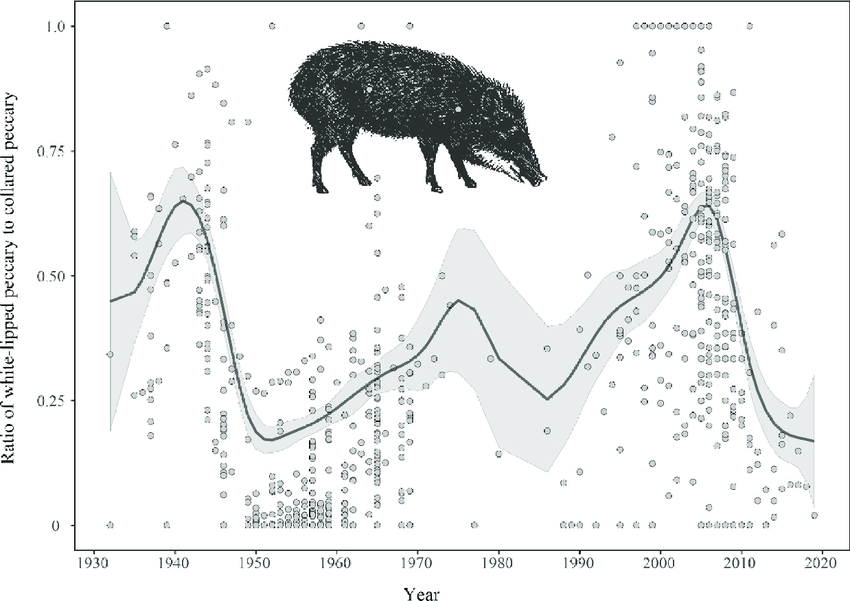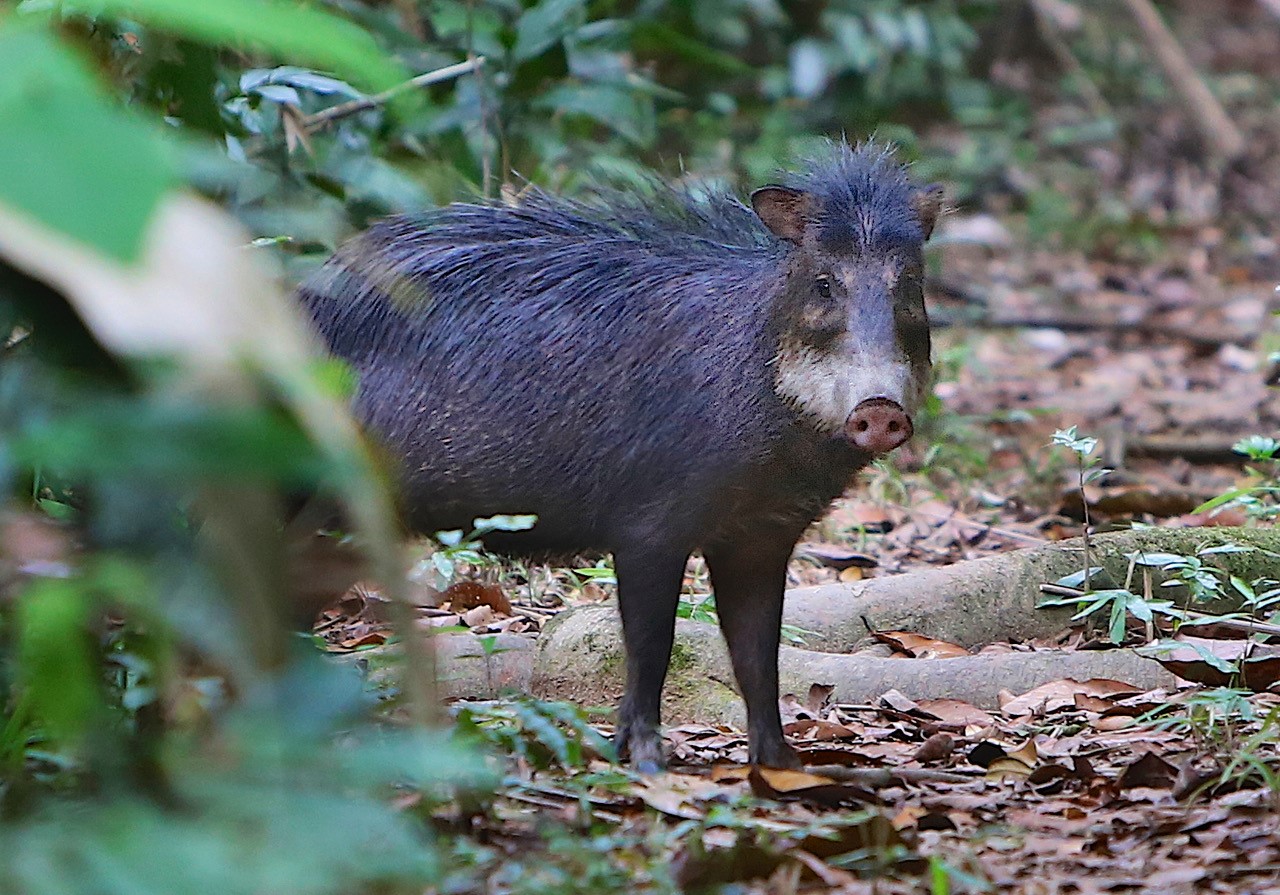- A new study attributes the regular disappearance of white-lipped peccaries in South America to natural population cycles.
- White-lipped peccaries are a keystone species and ecosystem engineers whose absence can have a detrimental effect on tropical forest health.
- Using scientific research, historical records and Indigenous lore, researchers have discovered regular boom and bust population cycles, often synchronized over huge areas.
- The researchers believe these cycles are caused by peccary populations outgrowing their habitat and warn that the species requires large expanses of intact forest to survive and thrive.
Scientists say they have solved the mystery behind the periodic disappearance and reappearance of the white-lipped peccary (Tayassu pecari) across huge areas of central and South America.
A new study suggests that white-lipped peccary populations become so big that they over-shoot their resources, which weakens the animals and makes them more vulnerable to disease and starvation. And while it is natural for animal populations to fluctuate, in the case of the white-lipped peccary, sudden crashes are cyclical and synchronized over a vast area.
The cycles take place over a 20- to 30-year period, with a rapid five-year decline and then a period of up to 12 years when peccaries completely disappear from an area. This can often occur simultaneously at a regional or even national level, as in the case of French Guiana.

Published in PLOS ONE, the multidisciplinary study was more than 30 years in the making and combines state-of-the-art modeling and on-the-ground observations with historical research and Indigenous knowledge. The research is thought to be the first documentation of how animal populations rise and fall naturally in the case a Neotropical (New World) species.
Considered a keynote species, the white-lipped peccary is a hoofed, pig-like mammal that lives in large herds of up to 100 animals and roams vast territories. Their foraging, digging and trampling makes them important ecological engineers, as they open up areas that allow other species to colonize the clearings and increase plant diversity in the forest.
The combined mass of one herd can be as much as 8,000 kilograms (17,637 pounds), and their impact on forest ecology as they move through the undergrowth is comparable to that of the African elephant (Loxodonta) and North American bison (Bison bison). They also spread seeds and disturb soil fungus, which supports carbon sequestration.

The peccaries also help to maintain forest mineral licks, which provide animals with nutrients such as phosphorus and calcium, and muddy forest wallows, in which animals roll in to help regulate their temperature. Sustaining these pools improves forest biodiversity by providing important breeding pools for amphibians, while the peccaries are also the preferred prey of the jaguar (Panthera onca).
“Peccaries have a major impact on the maintenance of tropical ecosystems,” says José Fragoso, the study’s lead author and researcher at the University of Brasília’s Zoological Department. “When they disappear it’s as if a forest reset button was pressed. … if white-lips are not present, what remains is a skeleton of the original ecosystem,” Fragoso tells Mongabay.
According to John Polisar, member of the International Union for Conservation of Nature’s Species Survival Commission, the report is important in documenting the cyclical highs and lows of an animal he describes as a crucial ecosystem architect. “Field researchers have a great respect for white-lipped [because] they are an indication that a place is still in a good shape,” he says.
Unlike in the tropical forests of Asia, Polisar says, where many different ungulates act as forest engineers, in South America it is largely down to peccaries and tapirs to fulfill that role, which is why studying them and finding new ways to conserve them is very important.
White-lipped peccaries are also an important hunting target for Indigenous people, and this significance is reflected in oral histories and local knowledge, which formed an important part of the research.
The study looked at 43 different disappearances at 38 sites in nine South American countries, with researchers sifting through nearly 100 years of hunting records to track the ups and downs of the population. These peaks and troughs correlated with the records and stories of Indigenous people. “The disappearances have become part of their mythology,” says Fragoso, for whom the research was about “piecing together bits of information until it makes sense.”
Andrew Taber, former Latin America program director at the Wildlife Conservation Society, has studied peccaries in the past and says he believes the study offers a compelling explanation of population cycling. But he also sees a wider conservation message in the report. “There are likely other forest species that go through some kind of population cycling,” he says, and studying and understanding why this happens is important for achieving other biodiversity and conservation goals.
Forest ecology is not just about the trees, Taber tells Mongabay. “It’s about all of these much more complex ecological processes that underpin them.”
“The boom-bust cycles make the peccaries susceptible to a greater number of threats,” says Fragoso, particularly land conversion and the fragmentation of their habitat, which can prevent them from reentering a region were a decline has occurred.

The analysis highlights the importance of large, continuous natural areas that enable source-sink dynamics, explains Fragoso. Peccaries flow from an area with abundant or super abundant populations (source), to areas where the population has become extinct (sink), often traveling over long distances to do so.
In the Amazon, where clear-cutting continues, corridors that link isolated patches of habitat are vital, says Fragoso. Government agencies also have an important role in managing peccary populations that are close to agricultural areas, where the species can become a pest. Some heavily regulated legalized hunting also needs to be supported, he adds.
Fragmentation is worse in places like Brazil’s Cerrado, where the white-lipped peccary became extinct 50 years ago, says Fragoso. The species is now being restored to protected areas, but this can bring problems. “Once an area is established without peccaries, people think they were never there and so they really don’t want them back,” he explains.
Citation
Fragoso, J.M.V, et al. (2022). Large-scale population disappearances and cycling in the white-lipped peccary, a tropical forest mammal. PLOS ONE. doi: https://doi.org/10.1371/journal.pone.0276297
Banner image: Regular disappearances of white-lipped peccary populations have long intrigued scientists, but new research shows that this could be part of a natural cycle. Image courtesy of Jose Fragoso.
Related coverage:
What is a white-lipped peccary? Candid Animal Cam is in South America
As Brazil ramps up rail projects, wildlife kills remain understudied
FEEDBACK: Use this form to send a message to the author of this post. If you want to post a public comment, you can do that at the bottom of the page.
